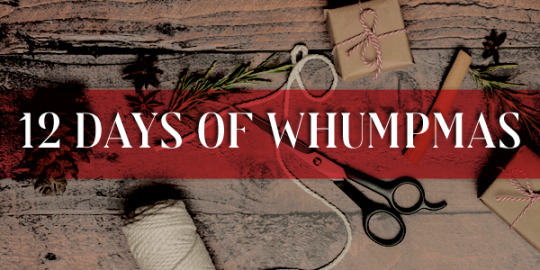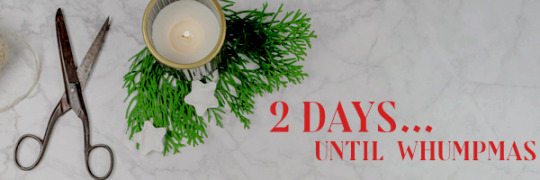#*snailoriginals
Explore tagged Tumblr posts
Text

12 DAYS OF WHUMPMAS. December 25, 2024 to January 5, 2025.
Anyone up for a mini-challenge for the holiday season? It's during a busy time but I figured it might be a nice distraction from family shit and something fun to do if you're lucky enough to have time off. It's the perfect length, it's not too overwhelming but not a sprint either.
There's three prompts for each day, two words/phrases and one dialogue. You can pick and choose or use all three. You can make something in any media, any length, it's up to you. You win the challenge if you create something and get inspired for the new year. It's that simple!
You can use the tag #12DaysofWhumpmas to share your stuff!
NOTE: Whump-typical dark content under the cut. What is 'whump'?
DAY 01: candle • sedative • "They told me everything."
DAY 02: frostbite • used as bait • "This is hopeless."
DAY 03: fire and ice • cabin • "Some things should stay buried, don't you think?"
DAY 04: captive • decoration • "God won't help you."
DAY 05: snowed in • delirious • "You can feel it, can't you?"
DAY 06: unresponsive • axe • "Of course it was you, I should've known."
DAY 07: present • pneumonia • "There's not much more we can do."
DAY 08: hammer • stitched up • "Why won't you talk to me?"
DAY 09: on their knees • wrapped • "Take a deep breath."
DAY 10: interrogation • miracle • "It's about sending a message."
DAY 11: ribbon and rope • dislocation • "They're not coming back."
DAY 12: prayer • scratched • "Well... it doesn't look good."
#writing community#writeblr#writblr#whump#writers of tumblr#writers on tumblr#writerscommunity#writeblrgarden#*snailoriginals#whump community#12daysofwhumpmas
129 notes
·
View notes
Text

ALMOST TIME FOR THE 12 DAYS OF WHUMPMAS!
What is it? It's a mini-challenge running from December 25th to January 5th (aka the 12 days of Christmas). So if you need something to keep you occupied during break/vacation or need a distraction from family chaos, look no further!
For each day, there are three prompts -- two words/phrases and one dialogue prompt. You can pick and choose or use all three. Create whatever you want! Original, fandom, whatever! The important thing is that you get your brain working and create something.
You can use the tag #12DaysofWhumpmas to share your stuff, it doesn't matter if you write something after the challenge is over.
#whump#writing community#writeblr#writblr#whump community#writeblrgarden#writeblr challenge#writing challenge#writers on tumblr#writers of tumblr#*snailoriginals
5 notes
·
View notes
Text



didn't want to go to sleep so i made some covers for my new idea (pictures courtesy of pexels, bless those photographers). the tip is about a nurse who takes justice into her own hands while working in a prison medical facility. with the help of one of the doctors, they target the most notorious inmate and the clock starts ticking.
jodie comer as the nurse. richard armitage as the doctor. mark-paul gosselaar as the prisoner.
#*snailmakesthings#*snailoriginals#bouncing in my head like the windows screen saver#no idea if i'll write it or how long it will be#its another idea revolving around justice in america#and the question 'how do you define justice?'#also revolves around biopolitics and social/civil death#needle tw#needles tw#sharp object tw#sharp objects tw#medical tw#hospital tw
1 note
·
View note
Text
Check out 12 Days of Whumpmas 2024 on Ao3! Prompts 4, 8, 10, 11, 12 haven't been posted because they're all half-written and I'm not capable of writing drabbles. I wish I could but I can't.
My favorite piece is prompt 6 because I wrote it a while ago, when I was going through some shit. It's not proofread very well because I focused on changing the pronouns (Jem started as she/her and developed into they/them) and I didn't want to read it again because I didn't want to sit there bawling.
1 note
·
View note
Text
stupidly excited about another new idea and it's got it all: murder couple, every power imbalance you could think of, awful men getting their comeuppance, the line between victim and perpetrator is constantly blurred, and no one is innocent.
1 note
·
View note
Text
I HAVEN'T FORGOTTEN ABOUT 12 DAYS OF WHUMPMAS! I'm exhausted from work, helping my mom buy a car, and then getting emotionally whacked yesterday. But it's supposed to snow tomorrow so maybe I'll get some time to myself! I also got a set of writing notebooks from Creator's Friend and I've started filling out one for the first book in the Swedish Series.
0 notes
Text
i was really excited to post my ficlet for day 4 and realized i'd written for the day 9 prompt instead... so yeah, i'm working on day 4 and 5 right now
0 notes
Text

inspo board for the pennsylvania series.
i didn't realize how much i love gillian flynn and daphne du maurier until i made these inspo boards! i think hilary mantel is working her way onto my favorites list too.
1 note
·
View note
Text

inspo board for the sweden series.
a bunch of different stuff that makes my brain go brrrr. i have the urge to reread one of us, it's a great look into norwegian culture, their criminal justice system, and the country's response to the attack. at the same time, i don't want to reread it because it left me with horrific images of the victims' last moments. it's a great true crime book, highly recommend, but you have to be in the right mindset to read it.
1 note
·
View note
Text

actually, ya know what, he's fuckable and punchable. an a+ candidate for john seed!
0 notes
Text
idk what kind of music The Detective (from the sweden series) listens to but i know she's allergic to tsw1ft
0 notes
Text
updated my WIPs page! some have been (temporarily) shelved and one has been added. it's something that's been knockin around in my head so i put it on there. it's inspired by the murdagh murders but the mastermind is a m!lf and everyone gets what's coming to them (even though rich americans don't typically suffer the consequences of their actions)
1 note
·
View note
Text

i'm stupidly excited about this, love when things line up 👀
0 notes
Text
I finished The Copenhagen Trilogy and The Trouble with Happiness: And Other Stories, both by Tove Ditlevsen and the Trilogy is one of those books that, as soon as I finished the library copy, I went out to buy my own. There's so many good quotes that are now tattooed on my brain. The first part of the series, Childhood/Barndom, hit the hardest.
0 notes
Text
sad it say that i can't finish baudrillard's simulation and simulacra. i like some of his theories but it's a real slog to get through. maybe one day i'll come back to it? idk
for now, i'm going to be pouring all of my fave hilary mantel and tove ditlevsen quotes into my queue. tove really, really, really gets me. except that she's romantically successful and i'm not but that's a different subject.
0 notes
Text
garbage's discography is literally jem! waiting for god is jem's young adult years dealing with the grief and turmoil that comes after her friend's death. then godhead and control describe jem's evolution into their destructive phase.
and of course queer is their life: 'The strangest of the strange / The coldest of the cool / You're nothing special here / A fake behind the fear / The queerest of the queer / Queerest of the queer'
0 notes